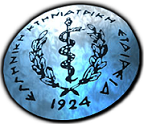Το τεκμήριο παρέχεται από τον φορέα :
 Ελληνική Κτηνιατρική Εταιρεία
Ελληνική Κτηνιατρική Εταιρεία
Αποθετήριο :
Περιοδικό της Ελληνικής Κτηνιατρικής Εταιρείας
| ΕΚΤ eJournals
